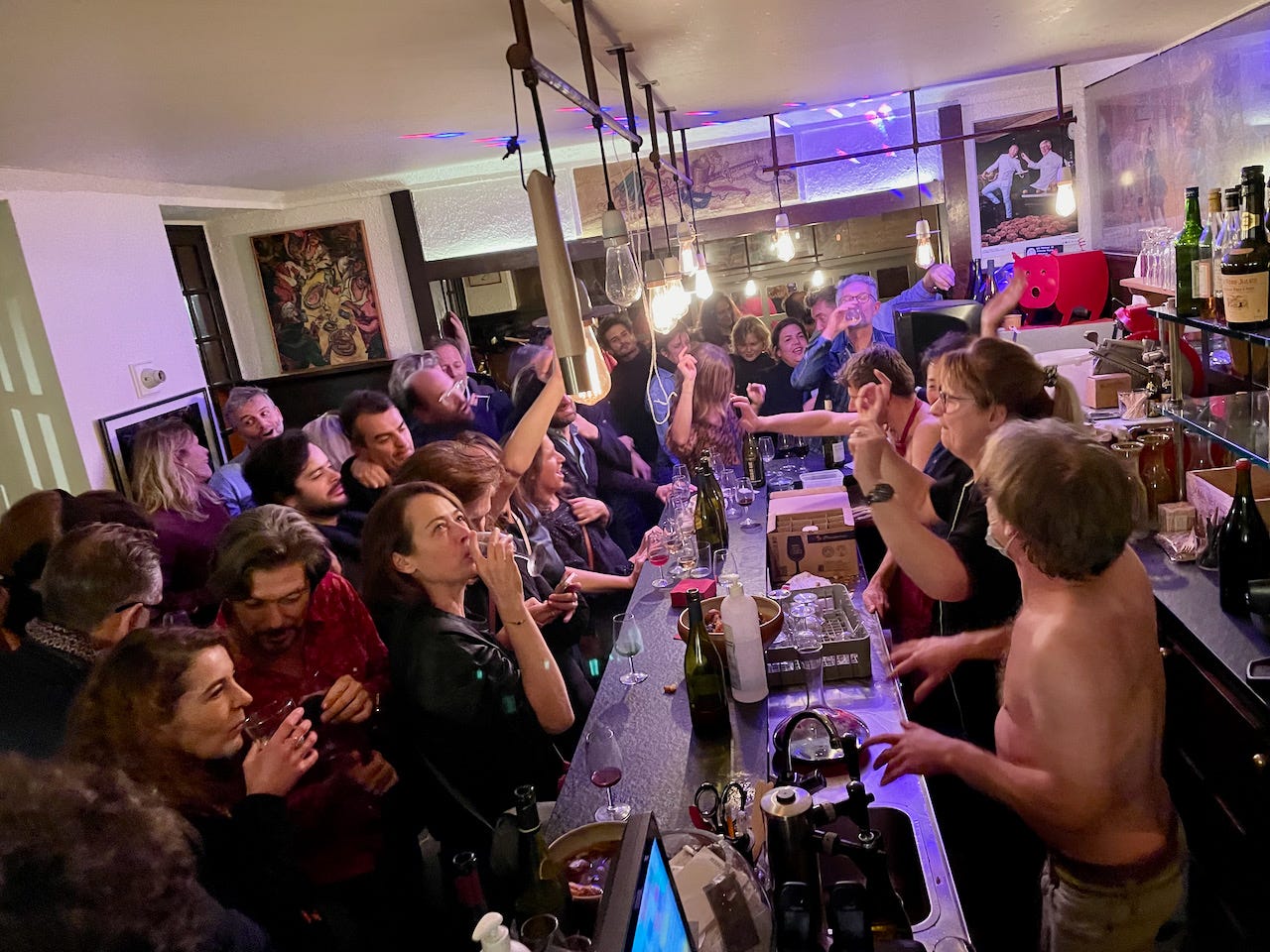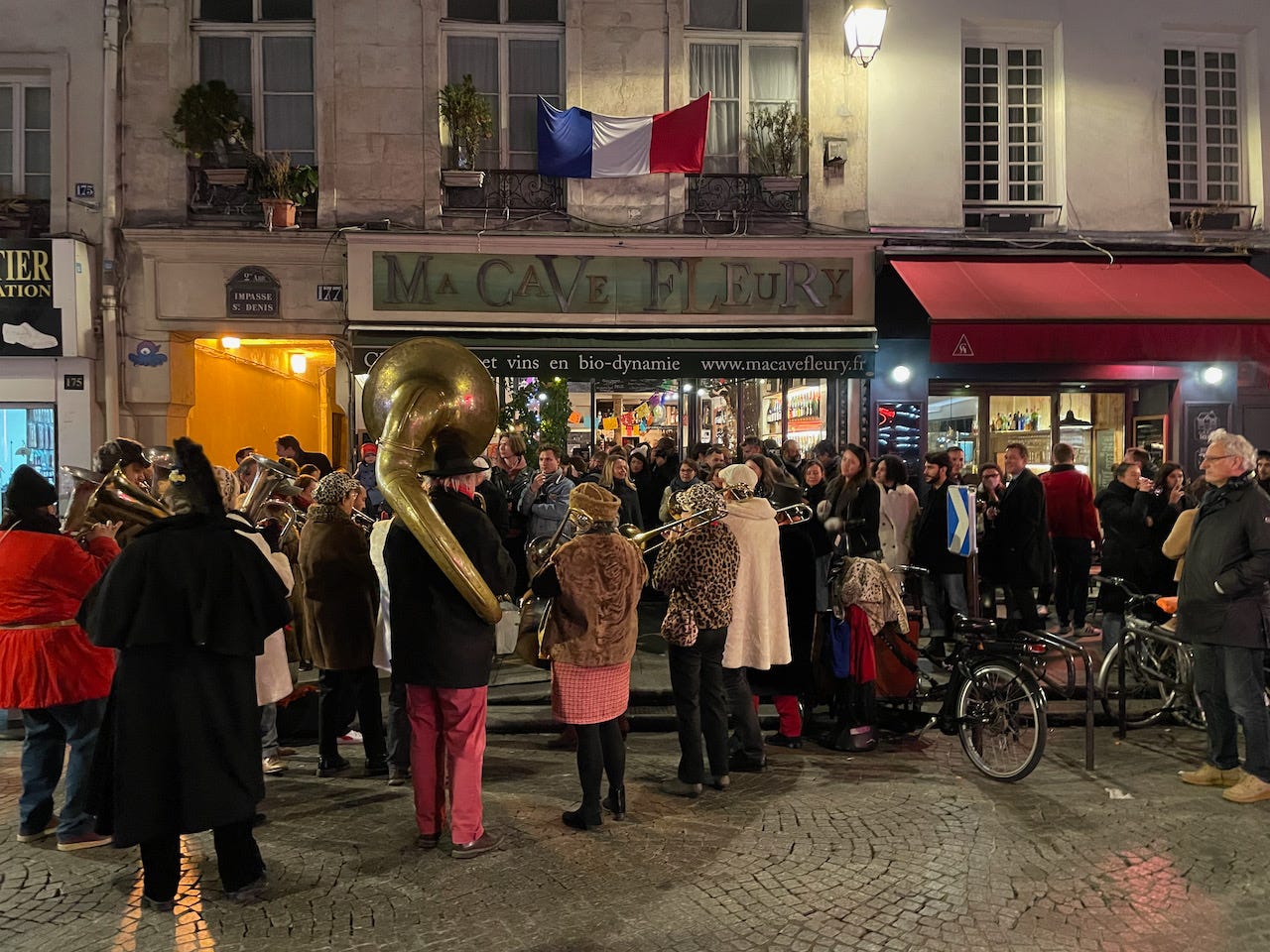The Beaujolais Nouveau Death March
It's that time of year again. Beaujolais Nouveau in Paris. Plus: Five natural Beaujolais vignerons give their takes on the 2021 vintage.

Last year, France’s COVID lockdown obliged me to taste the year’s Beaujolais primeurs on-site in the Beaujolais. This year, with Paris almost garishly open and unrestricted, my friends and I were able to conduct our traditional Beaujolais Nouveau Death March across the city, tasting the year’s primeurs as we went.
We began at La Quincave in Paris’ 6ème arrondissement, proceeding in a roughly northeast direction until terminating at 11ème arrondissement bistrot Le Repaire de Cartouche, where the colossal chef Rodolphe Paquin served various terrines and bowls of tripe, and where guests of honor included Mary-Jo Mimoun of Le Tagine and Rhône vigneron Réné-Jean Dard.
In between, we stopped at Les Caves du Panthéon, where Olivier Roblin hosted Aveyronnais vigneron Nicolas Carmarans; Le Garde Robe, where Charentay vigneron Quentin Harel tapped a barrel of primeur; Ma Cave Fleury, where Morgane Fleury had arranged a deafening brass fanfare band; and Le Verre Volé, where manager Thomas Vicente and his friend Edouard Vermynck of Entrée des Artistes played DJ sets to a dining room converted into a dance floor.
Fine fine fine, you might say. How were the wines?
2021 IN THE BEAUJOLAIS
I missed harvest season in the Beaujolais this year, being otherwise engaged in Faugères and the Veneto. My impressions of the vintage come from a pétanque game with Julie Balagny and Jean-Louis Dutraive in Fleurie just before harvest, and a few conversations with other vigneron friends since then. Here’s what they had to say.
Mathieu Lapierre - Villié-Morgon
There was a rainy spring, then frost several times in the springtime. It was quite humid and propitious to maladies. A complicated season. But there was also a social phenomenon. There were no tastings, no salons, no events outside the estates. So vignerons were present at their estates one-hundred-percent of the time. It was a good thing, given the vintage. There was work to do.
In terms of harvest, what worried me was we had bunches with a mediocre sanitary state. Even with all the sorting we did, it was impossible to have a one-hundred-percent percent healthy harvest. But we were in a vintage where the classic method worked. The wines are more gothic than rococo. Less festive, but very fine, with elegant fruit, and notes of peche de vigne.
Romain des Grottes - Saint-Etienne-des-Oullières
2021, in figures, is a complicated vintage. Twenty percent lost to frost, two hail episodes, and rain all the time from spring until harvest. It meant twice as much work without truly relaxing the tension. And half the results.
I’m happy with the wines in terms of quality (because I like low alcohol levels), but in terms of quantity it’s tight (about sixty-percent of a normal harvest).
From a philosophical perspective, 2021 is, on the other hand, an extraordinary year, because we leave our comfort zone. We’re confronted with the limits of our own business model.
Sebastien Congretel - Lantignié
A really complicated vintage for me. A bit of frost in the start of the season, then an incessant struggle against maladies, notably mildew, with treatment windows often so short that it was impossible to treat with the spray canister. So a big destruction of the harvest and a tiny yield. Happily I managed to buy a bit of grapes from organic friends in Lantignié.
Michele Smith-Chapel - Lantignié
The 2021 growing season felt like playing a game of whack-a-mole if you were on fire. Every time you felt like you had addressed a problem, another one popped up, and it continued like that throughout harvest.
Late frost early in the spring led to reduced yields which was coupled with disease pressure from excessive rainfall and a lack of sunshine, resulting in underripe grapes nearing harvest. A strong sorting was necessary and we dropped about eighty-percent of our grapes to the ground.
Elisa Guerin - Chénas
I think 2021 will be good. It depends where your vines are. There wasn’t a lot of ripeness, but you can do good things. It was easier to vinify. But we’ll see in time if it has the body to age or not. It resembles more 2012 than 2014, because there was no heat.
I’m happy with what we did, because we have low-lying vines. Which means we have a big ripeness, even in humid years. In Moulin-à-Vent, for example, I think we got a great balance. “Les Thorins” is a site that ripens very quickly, it’s very precocious. And since it’s a late-ripening year, I think it’ll make super wines.
WALLFLOWER WINES
What to add? The best of the 2021 Beaujolais primeurs are subdued, wallflower wines - and I mean this in the best possible way. Unshowy, pale, low in alcohol, they evoke the slender graces of 2000s Beaujolais, all crisp peach, mauve toile, and red apple. This sort of profile is what drew many drinkers to the Beaujolais in the first place (myself included), but it has grown rare amid the run of hot vintages that began in 2015. Given the low yields and exhausting vineyard treatment regimens that characterized the 2021 vintage for most vignerons, it would be insensitive to wish for more like this in the future. But hey. There are upswings.
Subscribers can check out my round-up of 2021 natural Beaujolais Nouveau (and other primeurs) here.
For anyone pressed for time, suffice it to say that Guy Breton’s luminous “Cuvée Fanchon” is, predictably, the best of the bunch, and that many of the 2021’s other great primeurs hail from outside the Beaujolais region. Of particular excellence are Nicolas Carmarans’ fer servadou “Minimus,” from Aveyron, and the Mosse brothers’ “Bangarang,” a perfumed Loire blend of sauvignon, grolleau, and pineau d’aunis. Both are bright, low-alcohol, high-energy wines, trumpet blasts for the new vintage, produced to a standard of purity that meets the rest of the vignerons’ oeuvres.
Aaron
Was this vintage report helpful ? There’s more where that came from - along with exclusive interviews, reports, and profiles - for Not Drinking Poison subscribers.
FURTHER READING
My November 2020 tasting of natural Beaujolais Nouveau.
My November 2020 profile of Elisa Guerin.
My 2016 profile of Romain des Grottes.



